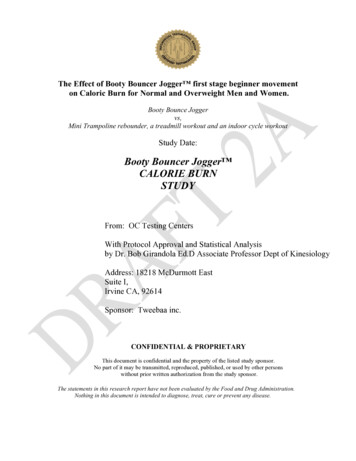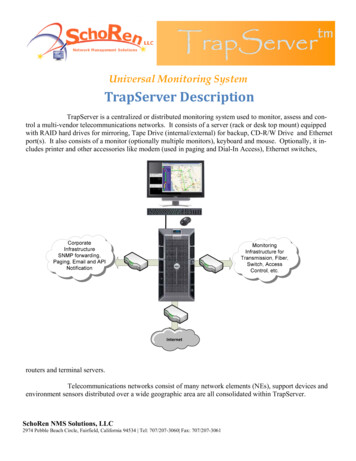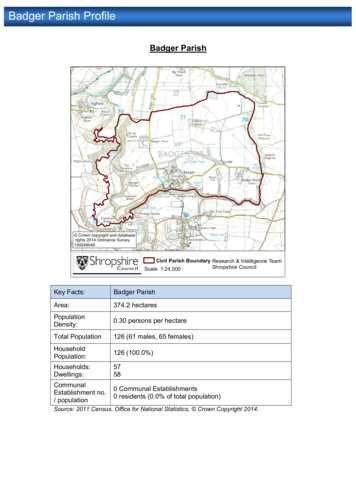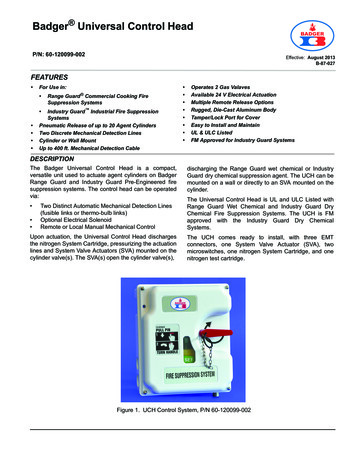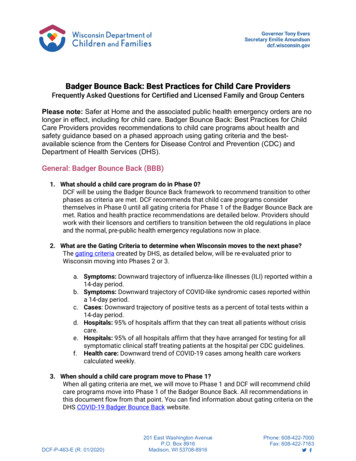
Transcription
Badger Bounce Back: Best Practices for Child Care ProvidersFrequently Asked Questions for Certified and Licensed Family and Group CentersPlease note: Safer at Home and the associated public health emergency orders are nolonger in effect, including for child care. Badger Bounce Back: Best Practices for ChildCare Providers provides recommendations to child care programs about health andsafety guidance based on a phased approach using gating criteria and the bestavailable science from the Centers for Disease Control and Prevention (CDC) andDepartment of Health Services (DHS).General: Badger Bounce Back (BBB)1. What should a child care program do in Phase 0?DCF will be using the Badger Bounce Back framework to recommend transition to otherphases as criteria are met. DCF recommends that child care programs considerthemselves in Phase 0 until all gating criteria for Phase 1 of the Badger Bounce Back aremet. Ratios and health practice recommendations are detailed below. Providers shouldwork with their licensors and certifiers to transition between the old regulations in placeand the normal, pre-public health emergency regulations now in place.2. What are the Gating Criteria to determine when Wisconsin moves to the next phase?The gating criteria created by DHS, as detailed below, will be re-evaluated prior toWisconsin moving into Phases 2 or 3.a. Symptoms: Downward trajectory of influenza-like illnesses (ILI) reported within a14-day period.b. Symptoms: Downward trajectory of COVID-like syndromic cases reported withina 14-day period.c. Cases: Downward trajectory of positive tests as a percent of total tests within a14-day period.d. Hospitals: 95% of hospitals affirm that they can treat all patients without crisiscare.e. Hospitals: 95% of all hospitals affirm that they have arranged for testing for allsymptomatic clinical staff treating patients at the hospital per CDC guidelines.f. Health care: Downward trend of COVID-19 cases among health care workerscalculated weekly.3. When should a child care program move to Phase 1?When all gating criteria are met, we will move to Phase 1 and DCF will recommend childcare programs move into Phase 1 of the Badger Bounce Back. All recommendations inthis document flow from that point. You can find information about gating criteria on theDHS COVID-19 Badger Bounce Back website.DCF-P-463-E (R. 01/2020)201 East Washington AvenueP.O. Box 8916Madison, WI 53708-8916Phone: 608-422-7000Fax: 608-422-7163
4. What criteria should be met in order to move to Phases 2 and 3?DHS will be regularly evaluating the Gating Criteria mentioned above to guide decisionsabout when Wisconsin is ready to move to the next phase.5. What if my municipality issued a local public health order?Providers must follow all local guidance and orders issued by their counties and publichealth departments.6. Does DCF recommend additional resources that may support child care programs inreopening?The Opening During COVID-19 document developed by the department providesadditional guidance for program-level questions to consider. In addition, a detaileddocument for proivders deciding whether to open was compiled and curated incollaboration with staff from the Wisconsin Early Childhood Association, The City ofMadison Child Care Unit, and in collaboration with Abbi Kruse, Executive Director, ThePlaying Field and Paul Newton, Executive Director, Big Oak Child Care.7. Do the waivers of administrative rule end with the expiration of the Safer at HomeOrder? What is happening with the emergency rules? Are all waivers staying in place toallow programs to best serve the needs of families in our communities?Yes. All administrative rules that were waived as a result of Governor Evers’ PublicHealth Emergency expired on May 11, 2020. As a result, the Department of Children andFamilies (DCF) has drafted a Statement of Scope and is working on drafting andimplementing Emergency Rules to provide continuity of care and best serve Wisconsinfamilies.8. Will the phase criteria in Badger Bounce Back (BBB) for child care coincide with otherstate requirements and processes for the BBB?DCF is working with other state agencies in an effort to be consistent to the extentpossible. The Badger Bounce Back for child care uses the Gating Criteria created by theDepartment of Health Services (DHS) and phased approach of the Badger Bounce Backfor Wisconsin. There are many ways in which the other state programs and processesare similar to DCF programs, but there will also be circumstances when the guidance orcriteria for child care may differ from other state requirements due to statutes,administrative codes, and other regulations.Ratios/Capacity/Enrollment9. What are the ratio and group size requirements for staff and children?Normal ratio and group size rules are in effect. The public health emergency orderchanges to ratios and group size are no longer in effect for child care.10. How do we open our capacity safely by balancing large group sizes and parents goingback to work?In recognition of the vast differences in the levels of spread of COVID-19 throughout thestate of Wisconsin, as well as how quickly a change within an individual communitycould occur, these guidelines in each phase will assist regulated child care programs in
determining their ability to increase capacity while still following applicable rules andregulations to keep children safe and healthy.Child care programs should: Comply with applicable licensing and certification ratio and group size requirementsMake informed and educated decisions regarding increasing child and staff capacitywithin their program (up to their licensed/certified capacity). In making this decision,consider the following:oooooooThe current spread of COVID-19 in the local community and/or countyWhether the program can implement emergency plans, such as a new outbreakof COVID-19 within the program or communityThe number of staff available to meet the regulation requirements and needs ofthe program (i.e. directors, teachers, cooks, drivers)The availability of substitute staff should regular staff become illWhether there is enough space within the learning environment, both indoors andoutdoors, to encourage physical distancing during activities, rest time, and mealtimes etc.Whether designated space is available to isolate a child who becomes ill while atthe program and awaits pickupWhether staff with PPE are available to remain with an isolated child whilewaiting for family to arrive11. Are there thoughts about how to be flexible to help keep people separated?Although each phase of the Badger Bounce Back best practices guidance for child careallows for increased capacity, we do encourage programs to keep the same groups ofchildren and staff together each day, without comingling, or using the same communalspaces. Individual programs requesting a change in how their programs operate shouldcontact their DCF licensing specialist.12. Essential workers are concerned about expanding child care group size because of thestrict safety protocols, especially in health care, and what that will mean for theirexposure risk. How should programs address these concerns?It is recommended that programs increase their capacity slowly and with increasedmeasures of precaution. Some programs may choose to keep all children of essentialhealth care workers in a separate classroom if that works for their individual situation.Communicate with families regularly to inform them of increased enrollment, as well asthe precautionary measures your program is taking to keep children and staff safe andhealthy.
Food, Supplies and Personal Protective Equipment (PPE)13. Food shortages or limits on food products has created an additional stressor on top ofsanitation and health. What should be done?DCF encourages providers to work with their Child and Adult Care Food Program(CACFP) representative, if applicable, regarding concerns about food shortages andmeeting nutritional requirements. The CACFP has issued guidance during the COVID-19health emergency and the US Department of Agriculture (USDA) has issued waivers andguidance regarding the Food Program. See the Department of Public Instruction’sCACFP website for further information. Programs not participating in the CACFP cancontact their licensing or certification specialist.14. If programs cannot obtain supplies, should they remain closed?The availability of cleaning and disinfecting supplies and PPE is necessary to keepchildren and staff healthy. DCF recognizes this concern and is working continuously tomake all attempts to obtain and distribute these needed supplies. Programs should takeinto consideration the needs and well-being of the staff and families they serve anddecide what is best for their program.15. There is limited or no access to thermometers for child care programs, which is a hugeissue if programs are expected to conduct health screenings with minimal touching andcross-contamination. What are programs’ options?DCF recognizes this is a concern. Programs should take precautions to clean anddisinfect thermometers after each use. Programs could also consider asking parents totake their child’s temperature prior to arriving at the program and report those results tothe program.Phase 0 and Phase 1 QuestionsHealth and Safety16. When should children or staff not be allowed in the program?Children and staff with a fever of 100.4 or above and/or signs of illness, such ascoughing or difficulty breathing, should stay home.17. Do I have to do a health screening of every child and staff upon arrival each day?DCF does not require health screenings; however, DCF encourages programs to considerimplementing one of the CDC recommended screening practices. There are threescreening options to consider.18. What should be done if a child or staff starts showing symptoms of COVID-19?Children who become ill must be separated in an isolated area until they are able to gohome. A designated staff person wearing PPE should stay with the child until the familyarrives. Staff who are ill should go home immediately.
19. What actions should a program take if there is exposure or a positive test result for achild or staff?Because COVID-19 is affecting different areas of the state in different ways, theresponse to exposures cannot be addressed in the same way throughout the state. If achild or staff member is diagnosed with COVID-19 you should contact your local publichealth department and your licensing specialist for next steps.Ratios, Capacity, and Enrollment20. Do children have to stay in the same group every day?In Phase 0 and Phase 1, it is recommended that groups remain consistent, with thesame children and staff together each day.21. Does a program need to prioritize essential workforce families during Phase 0?DCF encourages programs to continue to prioritize essential workforce families.However, if there are slots available after those essential workforce families are enrolled,programs may offer those slots to other families.22. What is the maximum capacity in Phase 0?All programs should consider the following factors when determining maximum capacity: The current spread of COVID-19 in the local community and/or countyWhether the program can implement emergency plans, such as a new outbreakof COVID-19 within the program or communityThe number of staff available to meet the regulation requirements and needs ofthe program (i.e. directors, teachers, cooks, drivers)The availability of substitute staff should regular staff become illWhether there is enough space within the learning environment, both indoors andoutdoors, to encourage physical distancing during activities, rest time, and mealtimes etc.Whether designated space is available to isolate a child who becomes ill while atthe program and awaits pickupWhether staff with PPE are available to remain with an isolated child whilewaiting for family to arriveDCF recommends programs use size limitations of up to 10 staff and 50 children. Allprograms must comply with applicable licensing and certification ratio and group sizerequirements.23. Does a program need to prioritize essential workforce families during Phase 1?DCF encourages programs to continue to prioritize essential workforce families.However, if there are slots available after those essential workforce families are enrolled,programs may offer those slots to other families.
24. What is the maximum capacity in Phase 1?All programs should consider the following factors when determining maximum capacity. The current spread of COVID-19 in the local community and/or countyWhether the program can implement emergency plans, such as a new outbreakof COVID-19 within the program or communityThe number of staff available to meet the regulation requirements and needs ofthe program (i.e. directors, teachers, cooks, drivers)The availability of substitute staff should regular staff become illWhether there is enough space within the learning environment, both indoors andoutdoors, to encourage physical distancing during activities, rest time, and mealtimes etc.Whether designated space is available to isolate a child who becomes ill while atthe program and awaits pickupWhether staff with PPE are available to remain with an isolated child whilewaiting for family to arriveDCF recommends programs with a licensed/regulated capacity of 75 or more childrenshould not exceed 75% of their licensed/regulated capacity during Phase 1. All programsmust comply with applicable licensing and certification ratio and group sizerequirements.Preventing the Spread of COVID-1925. What can be done to prevent COVID-19 from spreading in a program? Pick-up and Drop-Offo Stagger arrival and drop off timeso Programs can consider limiting adult entry to the facility (e.g., staff can bestationed at the front door, where families can drop children off)o Request one family member as the designated person for drop off/pick upo Provide hand sanitizer for adults at sign-in stations Cancel the use of volunteers and restrict nonessential visitors from entering thefacility Post signs on how to stop the spread of COVID-19, properly wash hands, promoteeveryday protective measures, and properly wear a face covering. Cancel field trips requiring transportation, where physical distancing cannot beaccommodated, or where shared equipment would be required (e.g., parks) Keep children 6 feet apart when possible (arrange the environment to increase thesize of learning centers or space materials further apart) During rest time, place resting equipment 6 feet apart, including cribs and arrangechildren head to toe
26. How should meals and snacks be served? All food service workers should have and wear PPE, such as gloves and face masks Family style meal service is not recommended - instead staff should serve food usinggloves or provide individual pre-plated meals Meals should be served in classrooms Children should be seated with 6 feet of distance in between each other wheneverpossible Encourage staff to sit with and talk to children, serving as role models and offeringsupport and normalcy during traumatic timesPhase 2 QuestionsHealth and Safety27. When should children or staff not be allowed in the program?Children and staff with a fever of 100.4 or above and/or signs of illness, such ascoughing, difficulty breathing should stay home.28. Do I have to do a health screening of every child and staff upon arrival each day?DCF does not require health screenings; however, DCF encourages programs to considerimplementing one of the CDC recommended screening practices. There are threescreening options to consider.29. What should be done if a child or staff starts showing symptoms of COVID-19?Children who become ill must be separated in an isolated area until they are able to gohome. A designated staff person wearing PPE should stay with the child until the familyarrives. Staff who are ill should go home immediately.30. What actions should a program take if there is exposure or a positive test result for achild or staff?Because COVID-19 is affecting different areas of the state in different ways, theresponse to exposures cannot be addressed in the same way throughout the state. If achild or staff member is diagnosed with COVID-19 you should contact your local publichealth department and their DCF licensing specialist for next steps.Ratios, Capacity, and Enrollment31. Do children have to stay in the same group every day?Groups should remain consistent with the same children and staff together each day.32. Are programs able to provide care to all families during Phase 2?Programs can provide care to all families during Phase 2. Programs should considerworking with their licensing specialist to make individual program decisions if limitedcapacity is a concern.
33. Are there limitations to the maximum capacity in Phase 2?All programs should consider the following factors when determining maximumcapacity. The current spread of COVID-19 in the local community and/or countyWhether the program can implement emergency plans, such as a new outbreakof COVID-19 within the program or communityThe number of staff available to meet the regulation requirements and needs ofthe program (i.e. directors, teachers, cooks, drivers)The availability of substitute staff should regular staff become illWhether there is enough space within the learning environment, both indoors andoutdoors, to encourage physical distancing during activities, rest time, and mealtimes etc.Whether designated space is available to isolate a child who becomes ill while atthe program at awaits pickupWhether staff with PPE are available to remain with an isolated child whilewaiting for family to arriveDCF recommends programs should not exceed licensed/regulated capacity and shouldconsider all factors before making decisions in Phase 2. All programs must comply withapplicable licensing and certification ratio and group size requirements.Preventing the Spread of COVID-1934. What can I do to prevent COVID-19 from spreading in my program? Pick-up and Drop-Offo Stagger arrival and drop off timeso Programs can consider limiting adult entry to the facility (e.g., staff can bestationed at the front door, where families can drop children off)o Request one family member as the designated person for drop off/pick upo Provide hand sanitizer for adults at sign-in stations Cancel the use of volunteers and restrict nonessential visitors from entering thefacility Post signs on how to stop the spread of COVID-19, properly wash hands, promoteeveryday protective measures, and properly wear a face covering. Cancel field trips requiring transportation, where physical distancing cannot beaccommodated, or where shared equipment would be required (e.g., parks)35. How should I serve meals and snacks? All food service workers should have and wear PPE, such as gloves and face masks Family style meal service is not recommended - instead staff should serve food usinggloves or provide individual pre-plated meals Meals should be served in classrooms Children should be seated with 6 feet of distance in between each other wheneverpossible
Encourage staff to sit with and talk to children, serving as role models and offeringsupport and normalcy during traumatic times.36. What are the major changes from Phase 1 to Phase 2? Provide care to all families Increase capacity Minimal mixing between groups Communal spaces used if necessary and cleaned and disinfected prior to a newgroup of children using the space Phase 3 QuestionsHealth and Safety37. Should programs continue to conduct daily health screenings of children and staff priorto entering the program?DCF does not require health screening; however, the CDC does recommendimplementing health screenings in phases 1-3.Ratios, Capacity, and Enrollment38. Do children have to stay in the same group every day?Programs can resume standard operations during this phase, while keeping in mindadditional health and safety precautions.39. Are there limitations to maximum capacity in Phase 3?Programs can resume standard operations during this phase, while keeping in mindadditional health and safety precautions. All programs should consider the number ofstaff available to meet the regulation requirements (i.e. directors, teachers, cooks,drivers), needs of the program, and ability to keep children and staff safe and healthywhen making capacity decisions.Programs may not exceed licensed/regulated capacity and must comply with applicablelicensing and certification ratio and group size requirements in Phase 3.40. Are ratio and group size requirements for children 5 years of age and older back tonormal?Programs not already operating at capacity may do so. Normal staff-to-child ratios for allages of children will be in effect.41. If needed, can programs exceed regulated capacity in Phase 3?Programs will not be able to exceed their regulated capacity. Programs should considerworking with their licensing specialist to make individual program decisions.
Day Camps42. What are best practices for day camps?DCF is currently has separate guidance for day camps.43. Will there be consistency in ratios and standards across child care and day camps?Yes. The recommendations are consistent from a licensing and health and safetystandpoint.
Health care: Downward trend of COVID-19 cases among health care workers calculated weekly. 3. When should a child care program move to Phase 1? When all gating criteria are met, we will move to Phase 1 and DCF will recommend child care programs move into Phase 1 of the Badger Bounce Back. All recommendations in this document flow from that point .



